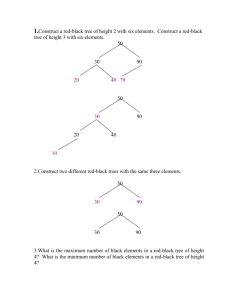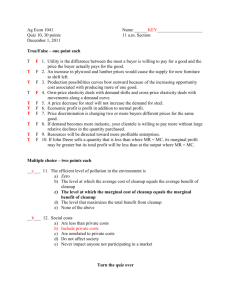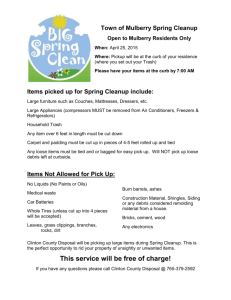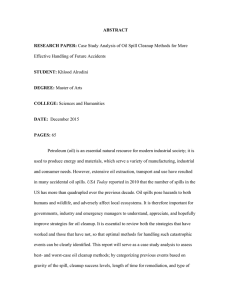Non-Linear Structures - Advanced Trees
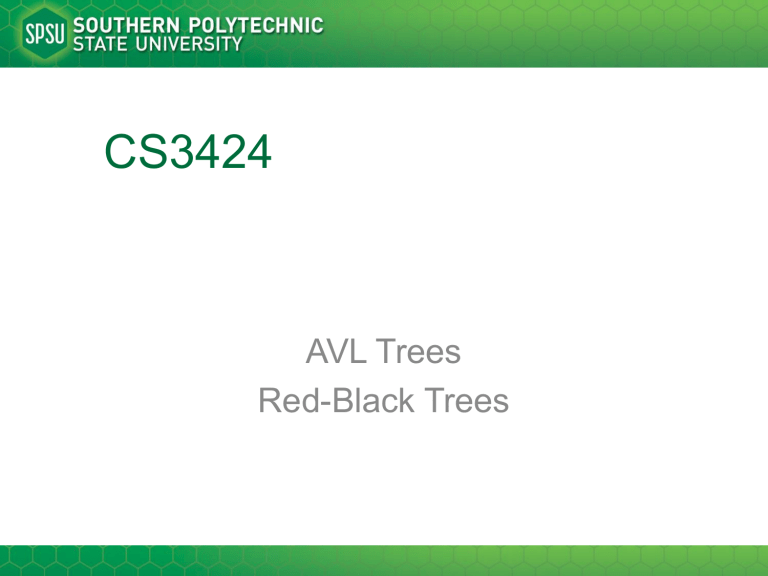
CS3424
AVL Trees
Red-Black Trees
Trees
• As stated before, trees are great ways of holding hierarchical data
• Insert, Search, Delete ~ O(lgN)
• But only if they’re balanced!
• So let’s discuss how to assure balance
Rotations
x
y
Left-Rotate(x)
Right-Rotate(y)
x
y
AVL Trees (1962)
• Uses height property to maintain balance
• Height of left & right differ by at most 1
• Uses rotations to restore balance after insertions and deletions
Balancing in AVL Trees
• Balance is the difference between the heights of the left and right subtrees
– This should range between -1 and 1
• Maintain this balance upon insert and delete
• Balance = H
R
- H
L
Left-Left Imbalance
Right-Rotate(X)
-1
Y
-2
X
Y
0
X
0
Left-Right Imbalance
+1
Y
-2
X
=
+1
Y
-1
-2
X
Left-Right Imbalance (cont)
+1
Y
-2
X
=
+1
Y
+1
-2
X
Left-Right Imbalance (
left)
+1
Y
-1
-2
X
Left-Right Imbalance (
left)
+1
Y
-1
-2
X
Left-Rotate(Y)
Y
-2
0
-2
X
Left-Right Imbalance (
left)
-2
Y
0
-2
X
Right-Rotate(X)
0
Y
0
X
+1
Left-Right Imbalance (
right)
+1
Y
+1
-2
X
Left-Right Imbalance (
right)
+1
Y
+1
-2
X
Left-Rotate(Y)
-1
Y
-1
-2
X
Left-Right Imbalance (
right)
-1
Y
-1
-2
X
Right-Rotate(X)
-1
Y
0
X
0
Red-Black Trees (1972/1978)
• BST + notion of color (RED / BLACK)
• Every node is either red or black
• Root is black
• Every leaf (NIL) is black
• If node red, both children are black
• For each node, path to NIL children contains same number of black nodes ( black-height )
Possibilities in Growing a Red-
Black Tree
Painting a Tree to be
Red-Black
Painting a Tree to be
Red-Black
Root is black
Painting a Tree to be
Red-Black
Must be black bh=1 bh=1
Painting a Tree to be
Red-Black
Painting a Tree to be
Red-Black
Painting a Tree to be
Red-Black
Must be black
Painting a Tree to be
Red-Black
Must be red
Painting a Tree to be
Red-Black bh = 2 or 3
Inserting & Deleting in Red-
Black Trees
• Insert similar to binary search trees
– “Search” left & right until finding NIL
– But now, we need to worry about coloring
– Requires possible rotations & “cleanup”
• Deleting similar to BSTs as well
– Search left & right until finding item
– If we removed a black node, “cleanup”
Red-Black Insert
• Insert node (z)
• z.Color = red
– This can cause two possible problems:
• Root must be black (initial insert violates this)
• Two red nodes cannot be adjacent (this is violated if parent of z is red)
– Cleanup
Red-Black Cleanup
• y = z’s “uncle”
• Three cases:
– y is red
– y is black and z is a right child
– y is black and z is a left child
Not mutually exclusive
Case 1 – z’s Uncle is red
• y.Color = black
• z.Parent.Color = black
• z.Parent.Parent.Color = red
• z = z.Parent.Parent
• Repeat cleanup
Case 1 Visualized
11
2
1 7
5 8 y z
4
New
Node
14
15 y.Color = black z.Parent.Color = black z.Parent.Parent.Color = red z = z.Parent.Parent
repeat cleanup
Case 1 Visualized
11
2
1 7
5 8 y z
4
New
Node
14
15 y.Color = black z.Parent.Color = black z.Parent.Parent.Color = red z = z.Parent.Parent
repeat cleanup
Case 1 Visualized
11
2
1 7
5 8 y z
4
New
Node
14
15 y.Color = black z.Parent.Color = black z.Parent.Parent.Color = red z = z.Parent.Parent
repeat cleanup
Case 1 Visualized
11
2
1 7
5 8 y z
4
New
Node
14
15 y.Color = black z.Parent.Color = black z.Parent.Parent.Color = red z = z.Parent.Parent
repeat cleanup
Case 1 Visualized
11
2
1 z
7
5 8
4
New
Node
14 y
15 y.Color = black z.Parent.Color = black z.Parent.Parent.Color = red z = z.Parent.Parent
repeat cleanup
Case 2 – z’s Uncle is black & z is a right child
• z = z.Parent
• Left-Rotate(T, z)
• Do Case 3
• Note that Case 2 is a subset of Case 3
Case 2 Visualized
11
2
1 z
7
5 8
4
14 y
15 z = z.Parent
Left-Rotate(T,z)
Do Case 3
Case 2 Visualized
11 z 2
1 7
5 8
4
14 y
15 z = z.Parent
Left-Rotate(T,z)
Do Case 3
Case 2 Visualized
11
7
1 z 2
5
8
4
14 y
15 z = z.Parent
Left-Rotate(T,z)
Do Case 3
Case 3 – z’s Uncle is black & z is a left child
• z.Parent.Color = black
• z.Parent.Parent.Color = red
• Right-Rotate(T, z.Parent.Parent)
Case 3 Visualized
11
7
1 z 2
5
8
4
14 y
15 z.Parent.Color = black z.Parent.Parent.Color = red
Right-Rotate(T, z.Parent.Parent)
Case 3 Visualized
11
7
1 z 2
5
8
4
14 y
15 z.Parent.Color = black z.Parent.Parent.Color = red
Right-Rotate(T, z.Parent.Parent)
Case 3 Visualized
11
7
1 z 2
5
8
4
14 y
15 z.Parent.Color = black z.Parent.Parent.Color = red
Right-Rotate(T, z.Parent.Parent)
Case 3 Visualized
7
1 z 2
5
4
11
8 14 y
15 z.Parent.Color = black z.Parent.Parent.Color = red
Right-Rotate(T, z.Parent.Parent)
Analysis of Red-Black Cleanup
C New z C
A
z B
D y
A D
B
Case 1
,
,
,
, and
are all black-rooted and all have same black-height
(symmetric L/R on A & B)
Analysis of Red-Black Cleanup
C
A
z B
y
Case 2
C
B
y
A z
Case 3
Case 2
,
,
, and
are all black-rooted and all have same black-height
(
is black or this would be case 1)
Analysis of Red-Black Cleanup
C B
y
A z
B
A z
C
y
Case 3
,
,
, and
are all black-rooted and all have same black-height
Questions about
Red-Black Insert
• What is the running time?
• Why are there only at most 2 rotations in the cleanup?
• How many times can the cleanup repeat (i.e. how many times can we have case 1 in a row)?
Red-Black Delete
• Delete as before
• But if you take away a black node:
– Black height is not “balanced”
– Can generate adjacent red nodes
– Must perform cleanup
• 4 cases
• “Beyond the scope of this course…”
FIN


